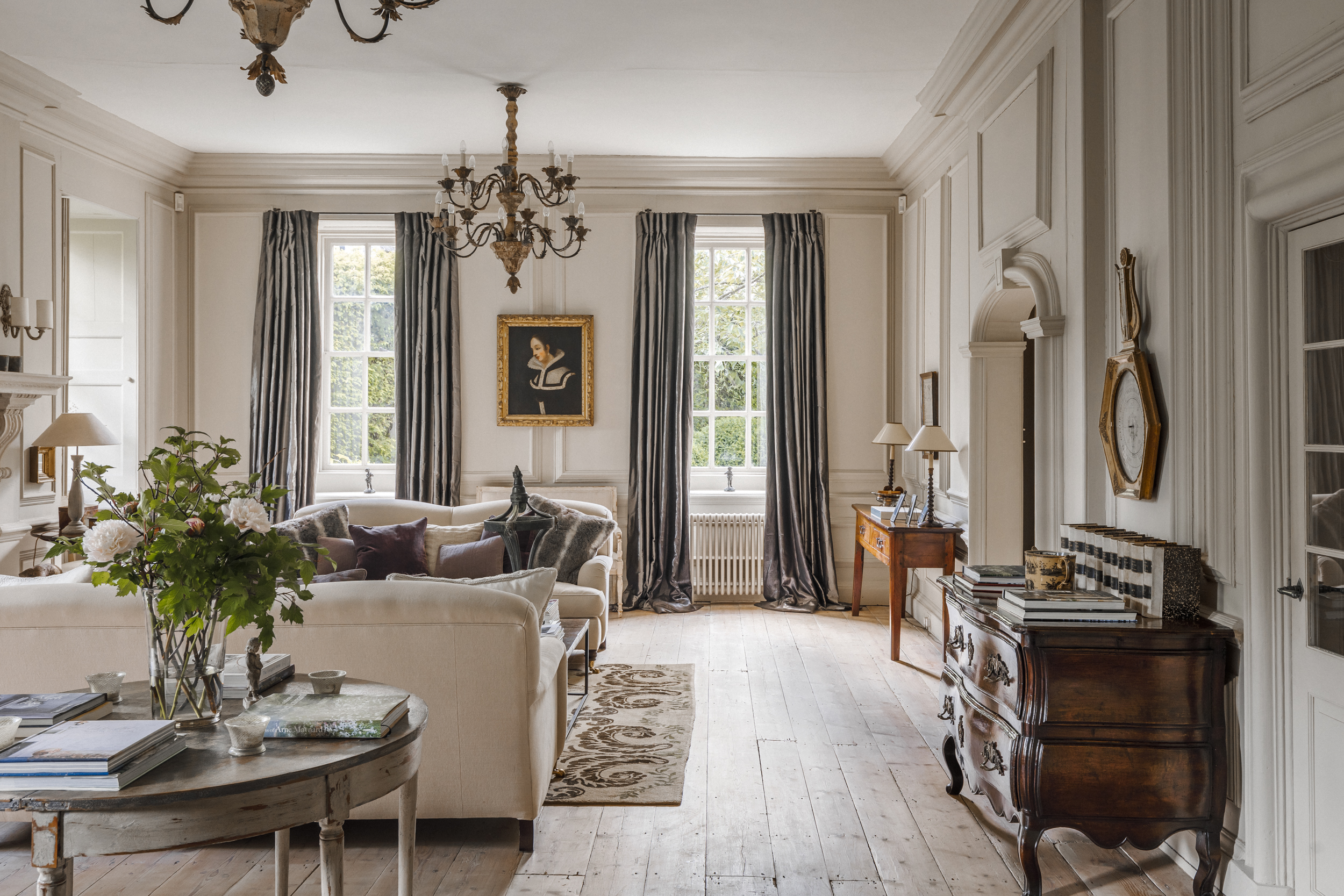The Grand Tour
Entry is to a large dual-aspect hall extending the depth of the building. A deep classical stucco arch, likely in place of the original rear wall, divides the hall, separating the entertaining and domestic spaces; antique barr grey limestone flags run underfoot.
On the right of the hallway is the reception room, which overlooks formal gardens and extends the full depth of the house. Originally two rooms, it was reconfigured by Wood to create the magnificent space seen today. Four large 12-pane sash windows flood the space with light, and there is direct access to gardens through French doors; original hardwood floorboards run underfoot. Wood also added fine plasterwork and panelling, creating a truly resplendent interior.
The dining room on the left of the hallway is more restrained. Here, walls are painted ‘Watttle’ by
Paint Library and are crowned by bolection coving; an 18th-century French limestone foliated fireplace acts as a focal point and adds symmetry to the room. The kitchen is large and square in plan. Wooden panelling topped with dentils lines the walls, and the floor is herringbone parquet. A six-door Aga is set in a pedimented alcove. On the left, behind a medieval doorway, is a walk-in pantry.
A voluminous passage runs behind the dining room and links the main hall with the kitchen. Beyond the passage is the garden room. This is a beautiful space with a pitched roof and exposed beams. A bath-stone double Belfast sink makes the space perfect for arranging flowers.
Bedrooms are set across the first and second floors, all arranged on a thoughtful and spacious plan. On the first floor are the four principal bedrooms, two of which are en suite, and a WC. The rooms all have exceptionally high ceilings. The two further bedrooms at the top of the house are limewashed and have original beams. These share a large spacious bathroom. All bedrooms have south-facing views of the avenue and open fields beyond.
The seamless blending of old and new in The Grange is exemplified in the bathrooms, where modern interventions have been added, yet rooms retain the original character. Bath stone chimneypieces contrast with contemporary hardware and roll-top baths. All bathrooms on the first floor have underfloor heating.
The Great Outdoors
The gardens have been designed by
Arne Maynard. Maynard’s practice is to create a garden with ‘a sense of place’, his work here seamlessly envelops the house creating wonderful vistas from every window in the house. Its stylistic variation creates the impression of building on historic landscaping with more contemporary interventions such as the dining area.
Finely manicured elements and are interspliced with more naturalistic planting. Doors open from the garden room to a large outdoor dining area, bounded by a cantilevered bench running around the perimeter. Here, topiary hedging is combined with plantings of Corsican mint, creating a wonderful scent, climbing and rambling roses along with a clematis run along the garden walls.
Tudor-inspired topiary next to the dining space is ordered and formal, in contrast to the raised flowerbeds with alliums, foxgloves, lavender, and shasta daisies.
A stone built garden pavilion lies at the edge of the gardens, fronted with a bank of medlar trees.
At the front of the house an espaliered quince grows between the windows underplanted by box hedging. A flagstone path, accompanied by further planting, leads to a large lawn with an avenue of lime trees. These frame a vista beyond the ha-ha to a two acre field which is bordered by the ancient River Boyd.
Out and About
The village of Bitton has a strong community atmosphere with a local shop, pub and a primary school. Conveniently located between Bath and Bristol, the centre of Bath is a 15-minute drive; the heart of Bristol is 20 minutes. The house is also well served by restaurants and country gastropubs,
The Pig near Bath, is a 20 minutes drive, whilst
The Swan Inn is in neighbouring Swineford along with
The Old Crown in nearby Kelston .
The area is renowned for its private and state schooling with institutions including Royal High, Royal High Junior School, Kingswood School, Kingswood Preparatory School, St Stephens’ Primary School and King Edward, Prior Park College.
Bristol has a rapidly growing independent food scene with a diverse selection of restaurants in the centre and various neighbourhoods. Clifton Village has an excellent selection of independent cafes and restaurants, including
Tradewind Espresso,
Spicer + Cole and
Pasta Loco on nearby Cotham Hill. The Michelin-starred
Casamia and sister restaurant
Paco Tapas, both founded by the Sánchez-Iglesias brothers, are notable highlights, as well as
Wilsons in Redland.
Little French in Westbury on Trym is also very well regarded.
Cultural activities and annual festivals are two-a-penny in Bristol;
Arnolfini and
Spike Island lead a well-regarded annual programme of contemporary exhibitions and performances.
The Watershed, a much-loved institution located along the harbourside, hosts talks and events alongside a programme of independent film screenings.
Bath Spa train station is a 15-minute drive with frequent trains to London in one hour 25 minutes.
Council Tax Band: E
